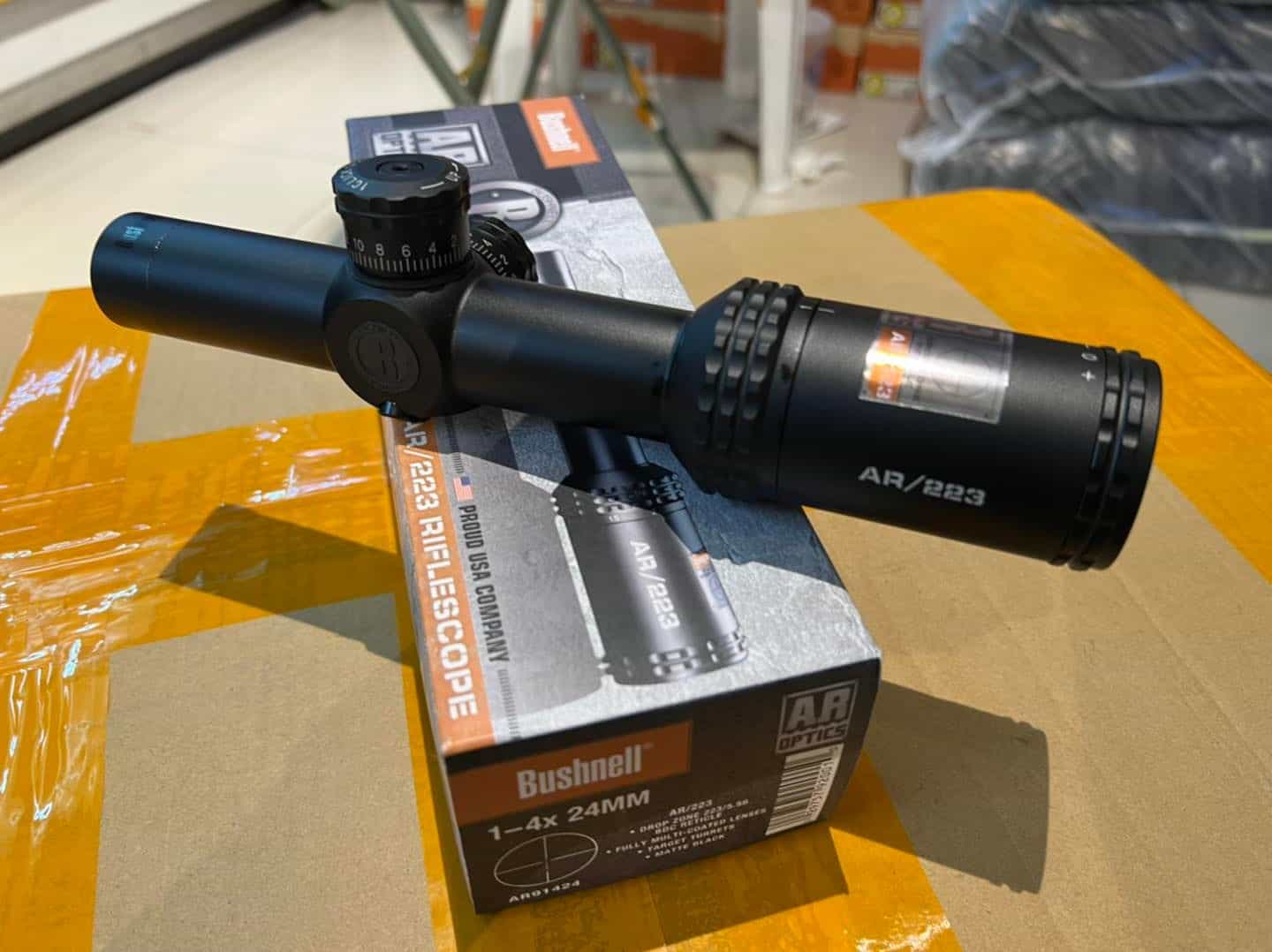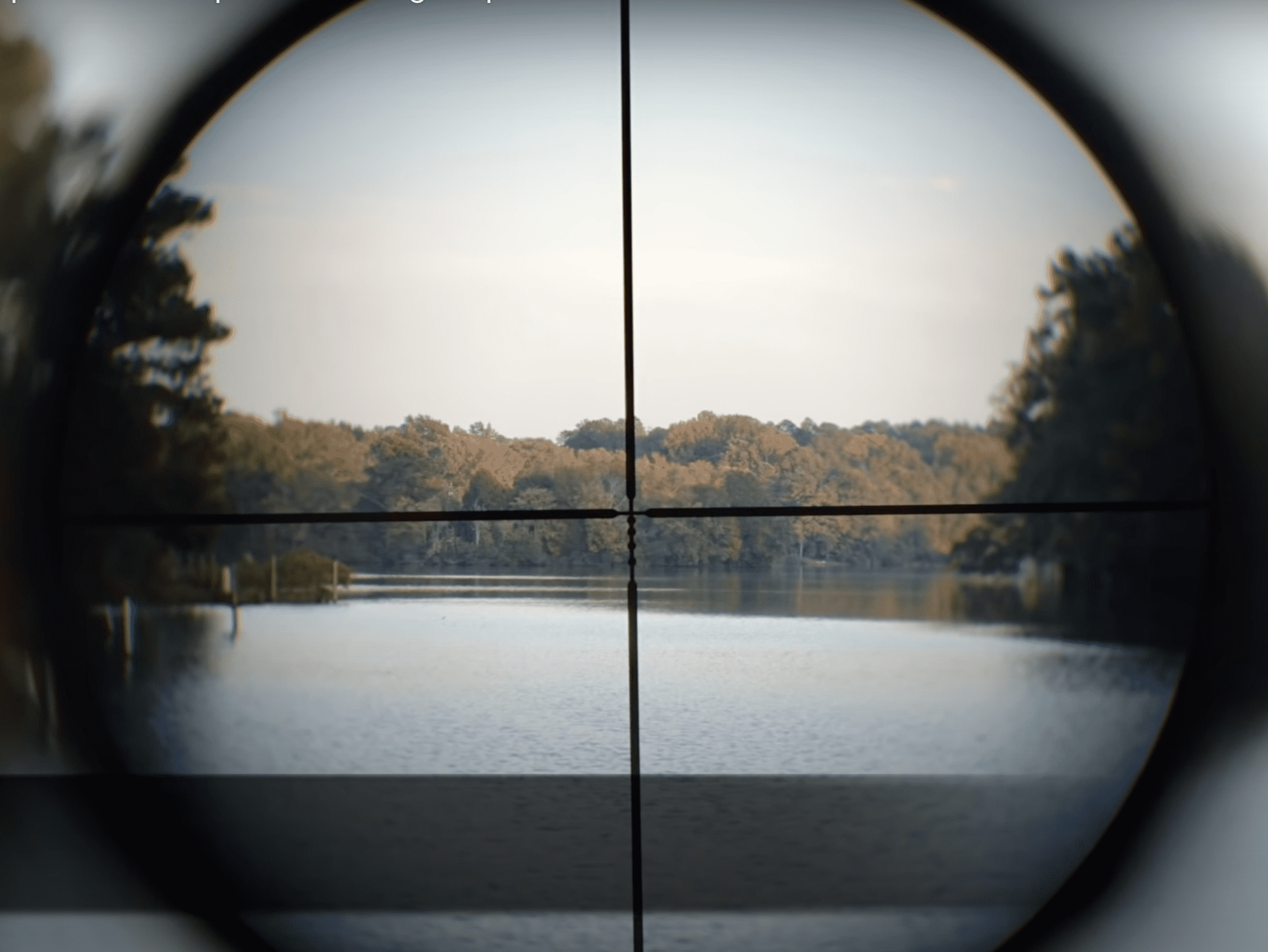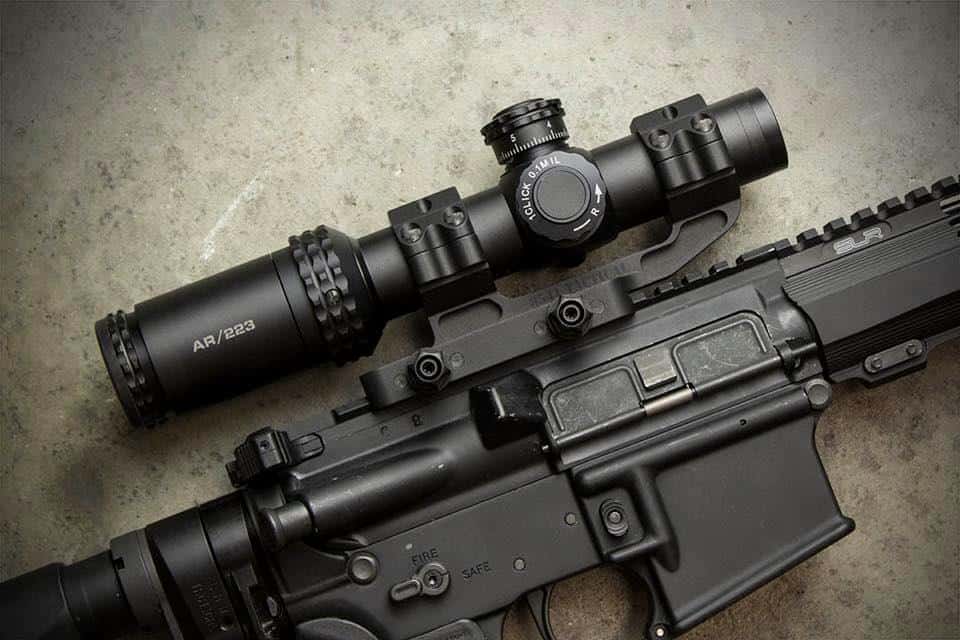When I decided to upgrade my AR-15 from iron sights to something more capable for both close-quarters work and medium-range precision, the Bushnell AR Optics 1-4x24mm kept surfacing in discussions with fellow shooters. After eight months of putting this low-power variable optic through everything from three-gun competitions to hog hunts, I can tell you exactly where it shines and where it falls short.
This isn’t your typical long-range precision glass – it’s purpose-built for the modern sporting rifle, and it shows in every design choice Bushnell made.
Why You Should Trust Me?
I’m not going to feed you some story about being a Navy SEAL or special forces operator – I’m just a regular guy who’s been passionate about firearms for most of my life. My dad started taking me hunting when I was a kid, and I’ve been shooting everything from antique rifles to modern sporting rifles ever since. Over the decades, I’ve accumulated quite a collection and shot with many more firearms than I could ever own.
What matters to me isn’t spec sheets – it’s whether an optic will help you make hits when the timer is running or when that coyote gives you a three-second window. Real-world performance under pressure is the only metric that counts.
How I Tested the Bushnell AR Optics
This LPVO lived on my go-to AR build – a Daniel Defense V7 in 5.56 NATO. I primarily shot 62-grain Federal Fusion and some handloaded 77-grain Sierra MatchKings, both of which this rifle loves. Over eight months, I logged roughly 1,200 rounds with this setup, covering three different three-gun matches, multiple training sessions, and two hunting trips in South Texas.
My focus was on rapid target transitions, close-range engagement speed, and how well the BDC holds worked for medium-range shots out to 400 yards. I also stressed the throw lever extensively – in competition, you’re constantly switching between 1x for close targets and 4x for precision shots.
Bushnell AR Optics 1-4x24mm Review
Bushnell AR Optics 1-4x24mm Specs
| Specification | Value |
|---|---|
| Magnification | 1-4x |
| Objective Lens | 24mm |
| Eye Relief | 3.5 inches |
| Field of View | 110-37 ft @ 100 yards |
| Tube Size | 30mm |
| Click Value | 0.1 MIL |
| Parallax | Fixed at 100 yards |
| Length | 9.5 inches |
| Weight | 16.9 ounces |
| Reticle | Drop Zone-223 BDC (SFP) |
| Waterproof Rating | IPX7 |
My Test Results
| Field Test | Measurement | Notes |
|---|---|---|
| Close Range Speed | 0.85 sec | Bill drill at 7 yards (average) |
| 100yd Precision | 0.5 MIL | Average of 4 five-shot groups |
| 200yd BDC Accuracy | 0.65 MIL | Using first BDC holdover |
| Transition Speed | 1.2 sec | 25yd to 100yd target switch |
| Throw Lever Function | Excellent | Smooth operation after 800+ uses |
| Glass Clarity | 7/10 | Clear center, minor edge distortion |
| Battery Life | 250+ hours | Medium illumination setting |
| Durability Test | Pass | Multiple drops, no zero shift |
Testing conducted using Daniel Defense V7 in 5.56 NATO with 62-grain Federal Fusion and 77-grain handloads.
Optical Performance & Reticle
The glass quality is exactly what you’d expect at this price point – functional but not spectacular. At 1x magnification, the image is crisp enough for fast target acquisition, though you’ll notice some slight tunneling compared to a true red dot. Bump it up to 4x and the glass holds together well enough for shots out to 300 yards, with acceptable edge clarity degradation that won’t impact your shooting.
The Drop Zone-223 BDC reticle is where this scope really earns its keep for tactical applications. The holdovers are calibrated for 55-62 grain .223 ammunition, and I found them to be dead-on at 200, 300, and 400 yards with my 62-grain loads. The reticle sits in the second focal plane, so your holdovers are only accurate at 4x magnification, but that’s exactly when you’d be using them anyway. If you’re specifically looking for optics optimized for this versatile cartridge, check out my comprehensive guide to the best scopes for .223.

Turret System & Tracking
Bushnell equipped this scope with exposed tactical turrets that click in 0.1 MIL increments – a smart choice that gives you precise adjustment capability without the complexity of 1/8 MOA clicks. The clicks are positive and audible, though not quite as crisp as premium options. I ran a tracking test by shooting a square pattern, and the scope tracked true through the entire range with minimal deviation.
The turrets aren’t resettable to zero, which is a minor inconvenience, but honestly, with the BDC reticle doing most of the heavy lifting for holdovers, I rarely found myself dialing much elevation. The windage turret got more use during competition for quick corrections between stages.
Magnification Range & Parallax
Here’s where this LPVO concept really works – the 1-4x range is perfect for most AR-15 applications. At 1x, you can engage targets rapidly with both eyes open, much like a red dot sight. The true 1x magnification means no tunneling effect that hampers some budget LPVOs. At 4x, you have enough magnification to make precise shots on smaller targets or extend your effective range.
The parallax is fixed at 100 yards, which works fine for most applications. I noticed slight parallax issues at very close ranges (under 25 yards), but it’s not significant enough to impact practical accuracy. The throw lever makes power changes nearly instantaneous – critical for three-gun stages where you’re transitioning between close and distant targets.
Eye Relief & Eye Box
The 3.5-inch eye relief is adequate for AR platform use, though you’ll want to pay attention to your scope mount height. I ran this with a standard cantilever mount and had no issues with scope bite, even during rapid-fire strings. The eye box is reasonably forgiving at 1x but gets tighter as you zoom in – typical behavior for any variable optic in this class.
During competition stages where I was shooting from awkward positions or had to quickly shoulder the rifle, I occasionally had to hunt for the sight picture at 4x magnification. It’s not a deal-breaker, but it’s something to be aware of if you’re planning to use this for dynamic shooting applications.
Build Quality
The construction quality impressed me more than I expected. The 30mm aluminum tube feels substantial, and the anodized finish has held up well despite some rough handling during competitions and transport. I’ve dropped this rifle (with scope attached) onto concrete twice during matches – both times the scope held zero perfectly.
The IPX7 waterproof rating isn’t just marketing speak. I used this scope during a particularly wet match in East Texas where we had steady rain for three hours. No fogging, no water intrusion, and the scope performed flawlessly. The turret markings remain clearly visible even when wet, which is more than I can say for some higher-priced optics I’ve used.
Mounting & Accessories
For this setup, I went with proven mounting solutions that complement the scope’s tactical role:
- Aero Precision Ultralight 30mm cantilever mount
- Blue Force Gear sling attachment points
- Butler Creek flip-up lens covers
- Basic lens cleaning kit
Performance Scores
| Category | Score | Notes |
|---|---|---|
| Optical Quality | 21/30 | Functional glass, minor edge distortion |
| Durability | 23/25 | Excellent build quality, proven reliability |
| Usability | 18/20 | Outstanding throw lever, good ergonomics |
| Value | 14/15 | Strong price-to-performance ratio |
| Features | 9/10 | Well-designed for intended use |
| Total Score | 85/100 | Excellent tactical LPVO for the money |
See how I test and rate scopes. Learn more
Advantages:
- True 1x magnification with no tunneling
- Excellent throw lever design and function
- Accurate BDC reticle for medium-range work
- Robust construction with proven durability
- Outstanding value for tactical applications
Drawbacks:
- Glass quality is adequate but not exceptional
- Eye box gets restrictive at higher magnifications
- Fixed parallax can be limiting for some applications
- Non-resettable turrets are inconvenient
How It Compares Against Similar Optics
| Model Comparison | Magnification | Optical Quality | Build Quality | Tracking | Value | Overall Rating |
|---|---|---|---|---|---|---|
| Bushnell AR Optics | 1-4×24 | Good | Excellent | Very Good | Outstanding | 85/100 |
| Vortex Crossfire II | 1-4×24 | Very Good | Very Good | Good | Very Good | 82/100 |
| Burris RT-6 | 1-6×24 | Very Good | Good | Very Good | Good | 81/100 |
| Primary Arms SLx | 1-6×24 | Good | Good | Good | Very Good | 79/100 |
The Vortex Crossfire II 1-4×24 delivers noticeably better glass quality and a more forgiving eye box, making it easier to use in demanding situations. However, the Bushnell edges it out with superior build quality and that outstanding throw lever design. The Vortex also costs about $50 more, which puts it in a different value category altogether.
The Burris RT-6 offers more magnification range with its 6x top end, and the glass quality is a step up from both the Bushnell and Vortex. The illuminated reticle is also brighter and more daylight-visible. That said, the Burris is considerably more expensive and the extra magnification isn’t always beneficial for close-quarters work.
Primary Arms SLx series scopes provide good competition with their various reticle options and solid build quality. I’ve extensively tested the Primary Arms SLx 1-6×24, and while it offers more sophisticated reticles, the Bushnell’s throw lever design proved superior in dynamic shooting scenarios.
What sets the Bushnell apart is its focus on practical tactical features rather than trying to be everything to everyone. The throw lever design is genuinely superior to most competitors, and the scope’s durability has proven itself in real-world applications.
Frequently Asked Questions
How does it perform in three-gun competition?
It’s actually excellent for three-gun work. The true 1x magnification and smooth throw lever make close-range engagements fast, while the 4x setting gives you enough magnification for longer rifle stages. The BDC reticle eliminates the need to dial turrets between distances, which saves precious time during stages.
Is the illumination bright enough for daytime use?
The illumination is adequate for low-light conditions but struggles in bright sunlight. It’s not as daylight-bright as a dedicated red dot, so you’ll be relying on the black reticle for most outdoor shooting. That’s not necessarily a problem since the etched reticle is always visible.
Will it handle .308/7.62 NATO recoil?
Absolutely. The scope is built like a tank and easily handles heavy recoiling cartridges. I’ve seen these mounted on everything from .300 Blackout to .308 AR-10 builds without any zero shift or mechanical issues. The robust 30mm tube design handles stress well.
How accurate is the BDC reticle?
Very accurate with standard 55-62 grain .223/5.56 loads. I found the holdovers to be spot-on out to 400 yards with 62-grain Federal ammunition. Heavier bullets like 77-grain may require some adjustment to the holds, but the basics work well for most common loadings.
Final Words
After eight months of serious use, the Bushnell AR Optics 1-4x24mm has proven itself to be a legitimate tactical LPVO that punches well above its weight class. This isn’t a scope trying to be everything to everyone – it’s focused on doing LPVO work exceptionally well at a price that won’t break your budget.
The throw lever alone is worth the price of admission. It’s smoother and more positive than competitors costing twice as much, and in dynamic shooting situations, that mechanical advantage translates to better performance when it matters. Add in the robust construction, accurate BDC reticle, and solid tracking, and you’ve got an optic that delivers professional-level capability at an amateur-friendly price.
Sure, the glass could be better, and yes, more expensive scopes will give you a brighter, crisper image. But when you’re engaging targets from 25 to 400 yards in a dynamic environment, the Bushnell gives you everything you need to make hits consistently. That’s what matters most in a tactical optic, and it’s exactly what this scope delivers.
If you’re building an AR for home defense, competition, or general tactical use, the Bushnell AR Optics deserves serious consideration. It’s one of those rare pieces of gear that exceeds expectations and proves that smart engineering can triumph over expensive materials. For shooters who need capability more than prestige, this LPVO is hard to beat.

Hi, I am Jerry L. Miculek and I am experienced firearms and optics expert. Guns are not just a hobby for me, they are my passion and life. You can learn more about me on my About page.